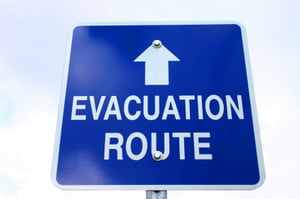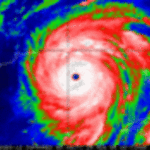Hurricanes bring drama, destruction and sometimes loss of life. If you live near the water you take hurricane season serious, you’re always prepared and at moments notice your ready to leave with family, pets and important papers.
Hurricanes are noted all over the world only as different names. In the western part of the North Pacific Ocean, near China, Formosa and Japan they are called typhoons. In the Bay of Bengal and the northern Indian Ocean, hurricanes are called cyclones. InAustralia they are called willie-willies. In the Philippine Islands they are called bagnios, the Cape of Good Hope, trovados. On the west coast of central America papagallos. The word hurricane comes from the name hunrakan, god of stormy weather of the Indians of Guatemala, a small country on the Caribbean Sea.
How do they Name Hurricanes?
The first to name hurricanes was Puerto Rico. Each one is named after the saint’s day on which it arrives. An example, the hurricane of July 26, 1825 blew down 7,000 houses, killed three hundred seventy four people was called Santa Ana.
In 1951 a conference of weathermen decided to tag hurricanes with the letters of the alphabet. For radio messages each letter was sent out as a word using the army alphabet code. Example, Able, Baker, Charlie, Dog ect. But then foreign weather stations in the Caribbean had just agreed to use other code words for the letters of the alphabet. Alpha, Bravo, Coca, Delta, Echo, Foxtrot. To solve the problem the next year the weathermen solved the problem by giving each hurricane of each year its own name, taken from a fixed alphabetical order from 1952 to 1954 the hurricanes of each year was named from this list. Alice, Barbara, Carol, Dolly, Edna, Frances, Ect.
Hurricanes and Interesting Facts:
Hurricanes and Horsepower:
The USA produces over 150 million horsepower. (One full grown hurricane can produce five hundred million horsepower, over three million times as much as the power produced by all the electric generators in the US put together.
Hurricane winds can be from 100 mph and above, a wind of 50 mph pushes with a force of 10 lbs on every square foot it strikes, a wind of 150 exerts a force nine times as great or 90 lbs on every square foot.
Storm Waves and Hurricanes:
The storms wave is the deadliest part of the hurricane. More than ¾ of all the deaths caused by hurricanes and other tropical cyclones are the result of storm waves that invade the land.
Hurricane winds carry thick clouds on their backs, near the center of the storm. The clouds reach down close to the ground and reach up into the air, to a height of eight miles, out of these clouds. Tons of water pours down in the torrential rain, sometimes as much rain will fall in a hurricane in one day as some cities get in a whole year.
Earthquakes and Hurricanes:
Earthquakes can occur at the same time as a hurricane, the heaving earth can launch a tsunami, a giant wave that sweeps in from the ocean.
Where do Hurricanes Begin?
Hurricanes begin where the sea is the warmest. The sea is the warmest where it gets the most sunlight, this happens near the equator ½ ways between the North Pole and South Pole.
The Caribbean Sea gets warmer and warmer as the sun passes over it on its way north in the springtime. It is the warmest during June and July, it warms up again during September and October as the sun passes over it, once more on its way south… Caribbean hurricanes usually come during June and July and again in September, October and November.
The ocean birthplace of the Cape Verde hurricanes is usually warmed up twice a year, once as the sun moves over it on its way north, and again when the sun returns on its trip south. It is also warmed by ocean currents that bring it warm water from other parts of the ocean, so it has only one warmest season. This season is August and September. The sea near the equator is still warm and can still form hurricanes.
How Long do Hurricanes Last?
August hurricanes last usually the longest with average of 12 days. July and November hurricanes last about 8 days. The average life span for hurricanes of north Atlantic is 9 ½ days tracking 5-15 miles an hour. At 15 mph it can travel 3,600 miles in 10 days. The storms usually are 300 miles wide.
Hurricanes always travel north; air over the North Atlantic Ocean is like a giant wheel turning slowly in the same direction. Hurricanes are born near the rim of the wheel. From Cape Verde Island the rim moves west crossing the ocean to the Caribbean. From the Caribbean it heads north and moves along the east coast of US, and then it moves east again and back across the Atlantic Ocean.
Myths about Hurricanes:
People think the center of the storms would be found where the wind is coming from. This isn’t true; winds go toward the center of the storm, not away from it. Because the rotation of the earth, they don’t go directly toward it but spiral around it. In the northern hemisphere to find the direction of the eye of the hurricane, stand with your back to the wind, then the eye of the storms will be on your left.
Signs of a Hurricane:
Tides will be higher than usual. In the Gulf of Mexico waves roll up the beach with a steady rhythm of 12 to 15 waves a minute. If the rhythm slows and 4 or 5 long swells come in each minute means a hurricane is somewhere behind the swell. In the sky is the high veil of ice crystals, clouds that move out ahead of the storm as the storm comes closer, a bar of low clouds appear on the horizon. Later gusty winds and showers, the air pressure falls and strong winds begin to blow.
Be smart be safe, have a hurricane or flood plan. Make sure everyone in the family knows what to do, have everything ready to grab and go and where to meet. Family and pets first. Don’t forget your elderly neighbors, talk to them ahead of time. Be smart it saves lives.





